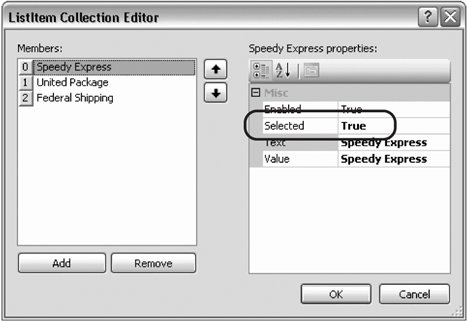Section 19.4. Adding Controls
19.4. Adding ControlsYou can add Server Controls to a Web Form in three ways: by writing HTML into the HTML page, by dragging controls from the toolbox to the Design page, or by pro-grammatically adding them at runtime. For example, suppose you want to use buttons to let the user choose one of three shippers provided in the Northwind database. You can write the following HTML within the <div> elements, in the HTML window: <div> <asp:RadioButton GroupName="Shipper" id="Speedy" text = "Speedy Express" Checked="True" runat="server" /> <asp:RadioButton GroupName="Shipper" id="United" text = "United Package" runat="server"/> <asp:RadioButton GroupName="Shipper" id="Federal" text = "Federal Shipping" runat="server" /> </div> The asp tags declare server-side ASP.NET controls that are replaced with normal HTML when the server processes the page. When you run the application, the browser displays three radio buttons in a button group ; pressing one deselects the others. You can create the same effect more easily by dragging three buttons from the Visual Studio toolbox onto the Form, or, to make life even easier, follow these steps:
Each radio button is given the default name ListItem, but you may edit its text and value in the ListItem properties, where you can also decide which of the radio buttons is selected, as shown in Figure 19-6.
Click OK to close the editor and then switch back and forth between the Design and Source tabs to see the effect of your changes, as shown in Figure 19-7. Figure 19-6. Editing a collection of list items I've numbered a few areas of interest in Figure 19-7. Number 1 shows the RadioButtonList control in the toolbox. Number 2 shows the smart tag on the RadioButtonList control on the form. Number 3 shows that you are looking at the properties of the RadioButtonList control, which has been named RadioButtonList1 for you by Visual Studio 2005 (but of course, you are free to change that in the Properties window), and Number 4 shows that the current RepeatDirection property is set to Vertical (setting it to horizontal will lay out the radio buttons horizontally). |
EAN: 2147483647
Pages: 250
